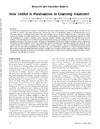Identificador persistente para citar o vincular este elemento:
https://accedacris.ulpgc.es/jspui/handle/10553/47094
| Título: | How useful is plastination in learning anatomy? | Autores/as: | Latorre Reviriego, Rafael Manuel García Sanz, María Paz Araceli Moreno Cascales, María Matilde Hernández Pina, Fuensanta Gil Cano,Francisco López Albors, Octavio Miguel Ayala Florenciano, María Dolores Ramírez Zarzosa, Gregorio José Vázquez Autón,José Maria Arencibia Espinosa, Alberto Henry, Robert W. |
Clasificación UNESCO: | 240101 Anatomía animal 310901 Anatomía 580107 Métodos pedagógicos 241002 Anatomía humana |
Palabras clave: | Sectional Anatomy Dissection Specimens Attitudes Tissue, et al. |
Fecha de publicación: | 2007 | Editor/a: | 0748-321X | Publicación seriada: | Journal of Veterinary Medical Education | Resumen: | In recent years plastination has begun to revolutionize the way in which human and veterinary gross anatomy can be presented to students. The study reported here assessed the efficacy of plastinated organs as teaching resources in an innovative anatomy teaching/learning system. The main objective was to evaluate whether the use of plastinated organs improves the quality of teaching and learning of anatomy. For this purpose, we used an interdepartmental approach involving the departments of Veterinary Anatomy, Human Anatomy, Veterinary Surgery, and Education Development and Research Methods. The knowledge base of control and experimental student groups was examined before and after use of the fixed or plastinated resources, respectively, to gather information evaluating the effectiveness of these teaching resources. Significant differences (p < 0.001). between control and experimental groups of Human and Veterinary Anatomy were observed in the post-test results. The Veterinary Surgery students had the most positive opinion of the use of plastinated specimens. Using these data, we were able to quantitatively characterize the use of plastinated specimens as anatomy teaching resources. This analysis showed that all the plastinated resources available were heavily used and deemed useful by students. Although the properties of plastinated specimens accommodate student needs at various levels, traditional material should be used in conjunction with plastinated resources. | URI: | https://accedacris.ulpgc.es/handle/10553/47094 | ISSN: | 0748-321X | DOI: | 10.3138/jvme.34.2.172 | Fuente: | Journal Of Veterinary Medical Education [ISSN 0748-321X], v. 34 (2), p. 172-176 |
| Colección: | Artículos |
Citas SCOPUSTM
102
actualizado el 08-jun-2025
Citas de WEB OF SCIENCETM
Citations
76
actualizado el 08-jun-2025
Visitas
81
actualizado el 27-abr-2024
Descargas
197
actualizado el 27-abr-2024
Google ScholarTM
Verifica
Altmetric
Comparte
Exporta metadatos
Los elementos en ULPGC accedaCRIS están protegidos por derechos de autor con todos los derechos reservados, a menos que se indique lo contrario.
